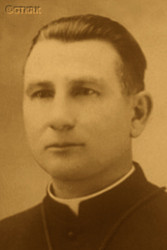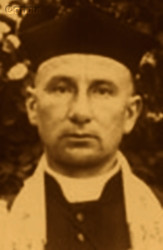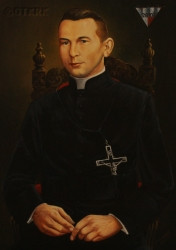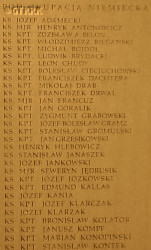Roman Catholic
St Sigismund parish
05-507 Słomczyn
85 Wiślana Str.
Konstancin deanery
Warsaw archdiocese, Poland
full list:
displayClick to display full list

searchClick to search full list by categories
wyświetlKliknij by wyświetlić pełną listę po polsku

szukajKliknij by przeszukać listę wg kategorii po polsku

Martyrology of the clergy — Poland
XX century (1914 – 1989)
personal data
religious status
Servant of God
surname
KAŁAS
surname
versions/aliases
KALLAS
forename(s)
Edmund
function
religious cleric
creed
Latin (Roman Catholic) Church RCmore on
en.wikipedia.org
[access: 2014.09.21]
congregation
Congregation of the Holy Family Missionaries MSFmore on
fr.wikipedia.org
[access: 2014.09.21]
(i.e. Missionaries of the Holy Family)
diocese / province
Polish Catholic Mission in France
MSF Polish Province
date and place
of death
07.06.1943

KL Mauthausenconcentration camp
today: Mauthausen, Perg dist., Salzburg state, Austria
more on
en.wikipedia.org
[access: 2022.01.09]
details of death
During World War I drafted in 1916 into German (Prussian) Imperial Army.
Took part in battles on the Western Front, in Verdun, among others.
Twice wounded.
Survived gas attack.
After rebirth of Poland soldier of the Polish Army.
Participant of Polish–Russian war of 1920.
Demobilised in 05.1921.
After German and Russian invasion of Poland in 09.1939 and start of the World War II, after the German attack in 06.1940 and the defeat of France, moved from the east of France to the collaborationist republic of Vichy.
There ministered among Polish refugees, soldiers and emigrants.
After the Germ. Fall Anton (Eng. Case Anton) on 10‐11.11.1942, when the German troops entered Vichy, ministered in the border zone between Vichy and the territories directly occupied by the Germans.
Arrested prob. at the beginning of 1943 by the Germans in Rosières (Lunery, Cher dep., France) for being a courier for the „Visigoths–Lorraine”, French–Polish clandestine resistance organisation, focusing mainly on smuggling Polish soldiers stranded in France to Spain and next to Great Britain, and distribution of Polish Primate Card.
August Hlond's „Le Delfi” brochure describing German atrocities in German occupied Poland.
Jailed in Bourges and Compiègne prisons.
Next on 22.04.1943 transferred to KL Mauthausen concentration camp (part of KL Mauthausen‐Gusen concentration camps' complex).
After „quarantine” completed on 25.05.1943 slaved in quarries.
Martyr in defence of the faith: during roll–call refused to proclaim Adolf Hitler a god.
Cruelly beaten up by German guards.
Taken to the camp's „hospital”, where perished.
prisoner camp's numbers
28187Click to display source page (KL MauthausenClick to display the description)
cause of death
murder
perpetrators
Germans
sites and events
KL MauthausenClick to display the description, KL Mauthausen‐GusenClick to display the description, Ribbentrop‐MolotovClick to display the description, Pius XI's encyclicalsClick to display the description, Polish‐Russian war of 1919‐1921Click to display the description
date and place
of birth
15.02.1899Birth certification on:
www.genealogiawarchiwach.pl
[access: 2025.09.08]

Wierzchucin Królewskitoday: Koronowo gm., Bydgoszcz pov., Kuyavia‐Pomerania voiv., Poland
more on
en.wikipedia.org
[access: 2021.12.18]
parents
KALLAS Joseph
🞲 1868, Zakrzewektoday: Więcbork gm., Sępólno Krajeńskie pov., Kuyavia‐Pomerania voiv., Poland
more on
en.wikipedia.org
[access: 2025.01.20] — 🕆 25.01.1902, ?

POLASIK Catherine
🞲 1880, ? — 🕆 ?, ?
religious vows
08.09.1927 (temporary)
presbyter (holy orders)
ordination
13.06.1932

Poznańtoday: Poznań city pov., Greater Poland voiv., Poland
more on
en.wikipedia.org
[access: 2021.07.18]
St Peter and St Paul the Apostles RC archcathedral churchmore on
en.wikipedia.org
[access: 2025.03.14]
positions held
till 1943
priest — Rosièrestoday: part of Lunery, Bourges arr., Cher dep., Centre‐Val de Loire reg., France
more on
en.wikipedia.org
[access: 2022.09.17] — among Polish emigrants and migrants; including: pastoral ministry in Hayange, Nancy and Valenciennes
from c. 1941
priest — Montluçontoday: Montluçon arr., Allier dep., Auvergne‐Rhône‐Alpes reg., France
more on
en.wikipedia.org
[access: 2022.09.17] — among the descendants of Polish prisoners of war from World War I (from 1916 there was a prisoner of war camp for Poles fighting on the side of Germany) and escapees from part of France occupied by Germans to the collaborationst republic of Vichy
c. 1940
priest — Alvignactoday: Gourdon arr., Lot dep., Occitanie reg., France
more on
en.wikipedia.org
[access: 2022.09.17] ⋄ refuge — for Poles running from part of France occupied by Germans to the collaborationst republic of Vichy
c. 1940
chaplain — Lacapelle‐Livrontoday: Montauban arr., Tarn‐et‐Garonne dep., Occitanie reg., France
more on
en.wikipedia.org
[access: 2022.09.17] ⋄ Livron subcamp, Caylus internment camp — run by the French from the collaborative republic of Vichy, for Polish soldiers that got stranded in France after the German attack in 06.1940 and the defeat of France
1939 – c. 1940
priest — Brieytoday: Meurthe‐et‐Moselle dep., Grand Est reg., France
more on
en.wikipedia.org
[access: 2022.06.29] — also in: Mancieulles, Tucquegnieux, Trieux, Homécourt, to Polish emigrants and migrant workers
1938 – 1939
priest — Rouvroytoday: Lens arr., Pas‐de‐Calais dep., Hauts‐de‐France reg., France
more on
en.wikipedia.org
[access: 2023.05.28] — among Polish emigrants and migrants
1935 – 1938
friar — Górka Klasztornatoday: part of Rataje village, Łobżenica gm., Piła pov., Greater Poland voiv., Poland
more on
en.wikipedia.org
[access: 2021.07.25] ⋄ Congregation's house, Missionaries of the Holy Family MSF — master of the novices and 1st assistant to the provincial
c. 1932 – 1935
friar — Wieluńtoday: Wieluń gm., Wieluń pov., Łódź voiv., Poland
more on
en.wikipedia.org
[access: 2021.07.18] ⋄ Philosophical Study (minor theological seminary), Congregation's house, Missionaries of the Holy Family MSF — catechist and Latin professor
c. 1926 – 1927
novitiate — Missionaries of the Holy Family MSF
1926
accession — Missionaries of the Holy Family MSF
1923 – 1926
employee — Bydgoszcztoday: Bydgoszcz city pov., Kuyavia‐Pomerania voiv., Poland
more on
en.wikipedia.org
[access: 2021.06.20] ⋄ Town (county) Court
others related
in death
BYTOŃSKIClick to display biography Felix, DORSZClick to display biography Bruno, FEDOROWICZClick to display biography Ceslav, GIELECClick to display biography Vladislav Emil, GRZĄDKAClick to display biography Hippolytus, KRUPIŃSKIClick to display biography Marian Alexander, KRZYSZKOWSKIClick to display biography Ceslav, MAKIELAClick to display biography Theodore Francis, ROGACZEWSKIClick to display biography Adalbert Theophilus, SIBILSKIClick to display biography Julian, WARTAŁOWICZClick to display biography Alexander (Fr Boleslav)
sites and events
descriptions
KL Mauthausen: German Germ. Konzentrationslager (Eng. concentration camp) KL, „Grade III” (Germ. „Stufe III”), part of KL Mauthausen‐Gusen complex, intended for the „Incorrigible political enemies of the Reich”. The prisoners slaved at a nearby granite quarry, but also in local private companies. Set up in 08.1938 initially served as a prison camp for common criminals, prostitutes and other categories of „Incorrigible Law Offenders”, but on 08.05.1939 was converted into a labour camp for political prisoners. (more on: en.wikipedia.orgClick to attempt to display webpage
[access: 2014.03.10])
KL Mauthausen‐Gusen: A large group of German Germ. Konzentrationslager (Eng. concentration camp) KL camps set up around the villages of Mauthausen and Gusen in Upper Austria, c. 30 km east of Linz, operational from 1938 till 05.1945. Over time it became of the largest labour camp complexes in the German‐controlled part of Europe encompassing four major camps concentration camps (KL Mauthausen, KL Gusen I, KL Gusen II and KL Gusen III) and more than 50 sub‐camps where inmates slaved in quarries — the granite extracted, previously used to pave the streets of Vienna, was intended for a complete reconstruction of major German towns according to the plans of the chief architect of National Socialist Germany, the Germ. Generalbauinspektor für die Reichshauptstadt (Eng. General Building Inspector for the Reich Capital) and from 1942 also, i.a. the Germ. Reichsminister für Bewaffnung und Munition (Eng. Reich Minister for Armaments and Ammunition), Albert Speer — munitions factories, mines, arms factories and Me 262 fighter‐plane assembly plants. The complex served the needs of the German war machine and also carried out extermination through labour. Initially did not have a its own gas chamber and the intended victims were mostly moved to the infamous euthanasia center in the Schloss Hartheim castle w Alkoven, 40.7 km east, or killed by lethal injection and cremated in the local crematorium. Later a van with the exhaust pipe connected to the inside shuttled between KL Mauthausen and KL Gusen. In 12.1941 a permanent gas chamber was built. C. 122,000‐360,000 of prisoners perished. Many Polish priests were held, including those captured during the program of extermination of Polish intelligentsia («Intelligenzaktion»). The camp complex was founded and run as a source for cheap labour for private enterprise. (more on: en.wikipedia.orgClick to attempt to display webpage
[access: 2014.03.10])
Ribbentrop‐Molotov: Genocidal Russian‐German alliance pact between Russian leader Joseph Stalin and German leader Adolf Hitler signed on 23.08.1939 in Moscow by respective foreign ministers, Mr. Vyacheslav Molotov for Russia and Joachim von Ribbentrop for Germany. The pact sanctioned and was the direct cause of joint Russian and German invasion of Poland and the outbreak of the World War II in 09.1939. In a political sense, the pact was an attempt to restore the status quo ante before 1914, with one exception, namely the „commercial” exchange of the so‐called „Kingdom of Poland”, which in 1914 was part of the Russian Empire, fore Eastern Galicia (today's western Ukraine), in 1914 belonging to the Austro‐Hungarian Empire. Galicia, including Lviv, was to be taken over by the Russians, the „Kingdom of Poland” — under the name of the General Governorate — Germany. The resultant „war was one of the greatest calamities and dramas of humanity in history, for two atheistic and anti‐Christian ideologies — national and international socialism — rejected God and His fifth Decalogue commandment: Thou shall not kill!” (Abp Stanislav Gądecki, 01.09.2019). The decisions taken — backed up by the betrayal of the formal allies of Poland, France and Germany, which on 12.09.1939, at a joint conference in Abbeville, decided not to provide aid to attacked Poland and not to take military action against Germany (a clear breach of treaty obligations with Poland) — were on 28.09.1939 slightly altered and made more precise when a treaty on „German‐Russian boundaries and friendship” was agreed by the same murderous signatories. One of its findings was establishment of spheres of influence in Central and Eastern Europe and in consequence IV partition of Poland. In one of its secret annexes agreed, that: „the Signatories will not tolerate on its respective territories any Polish propaganda that affects the territory of the other Side. On their respective territories they will suppress all such propaganda and inform each other of the measures taken to accomplish it”. The agreements resulted in a series of meeting between two genocidal organization representing both sides — German Gestapo and Russian NKVD when coordination of efforts to exterminate Polish intelligentsia and Polish leading classes (in Germany called «Intelligenzaktion», in Russia took the form of Katyń massacres) where discussed. Resulted in deaths of hundreds of thousands of Polish intelligentsia, including thousands of priests presented here, and tens of millions of ordinary people,. The results of this Russian‐German pact lasted till 1989 and are still in evidence even today. (more on: en.wikipedia.orgClick to attempt to display webpage
[access: 2015.09.30])
Pius XI's encyclicals: Facing the creation of two totalitarian systems in Europe, which seemed to compete with each other, though there were more similarities than contradictions between them, Pope Pius XI issued in 03.1937 (within 5 days) two encyclicals. In the „Mit brennender Sorge” (Eng. „With Burning Concern”) published on 14.03.1938, condemned the national socialism prevailing in Germany. The Pope wrote: „Whoever, following the old Germanic‐pre‐Christian beliefs, puts various impersonal fate in the place of a personal God, denies the wisdom of God and Providence […], whoever exalts earthly values: race or nation, or state, or state system, representatives of state power or other fundamental values of human society, […] and makes them the highest standard of all values, including religious ones, and idolizes them, this one […] is far from true faith in God and from a worldview corresponding to such faith”. On 19.03.1937, published „Divini Redemptoris” (Eng. „Divine Redeemer”), in which criticized Russian communism, dialectical materialism and the class struggle theory. The Pope wrote: „Communism deprives man of freedom, and therefore the spiritual basis of all life norms. It deprives the human person of all his dignity and any moral support with which he could resist the onslaught of blind passions […] This is the new gospel that Bolshevik and godless communism preaches as a message of salvation and redemption of humanity”… Pius XI demanded that the established human law be subjected to the natural law of God , recommended the implementation of the ideal of a Christian state and society, and called on Catholics to resist. Two years later, National Socialist Germany and Communist Russia came together and started World War II. (more on: www.vatican.vaClick to attempt to display webpage
[access: 2023.05.28], www.vatican.vaClick to attempt to display webpage
[access: 2023.05.28])
Polish‐Russian war of 1919‐1921: War for independence of Poland and its borders. Poland regained independence in 1918 but had to fight for its borders with former imperial powers, in particular Russia. Russia planned to incite Bolshevik‐like revolutions in the Western Europe and thus invaded Poland. Russian invaders were defeated in 08.1920 in a battle called Warsaw battle („Vistula river miracle”, one of the 10 most important battles in history, according to some historians). Thanks to this victory Poland recaptured part of the lands lost during partitions of Poland in XVIII century, and Europe was saved from the genocidal Communism. (more on: en.wikipedia.orgClick to attempt to display webpage
[access: 2014.12.20])
sources
personal:
pl.wikipedia.orgClick to attempt to display webpage
[access: 2012.11.23], misjonarzemsf.plClick to attempt to display webpage
[access: 2018.10.04], www.gedenkstaetten.atClick to attempt to display webpage
[access: 2018.10.04], www.genealogiawarchiwach.plClick to attempt to display webpage
[access: 2025.09.08], www.hagiographycircle.comClick to attempt to display webpage
[access: 2012.11.23]
original images:
www.meczennicy.pelplin.plClick to attempt to display webpage
[access: 2013.05.19], www.meczennicy.pelplin.plClick to attempt to display webpage
[access: 2013.05.19], poslaniecmsf.plClick to attempt to display webpage
[access: 2017.11.07], www.katedrapolowa.plClick to attempt to display webpage
[access: 2014.01.16]
LETTER to CUSTODIAN/ADMINISTRATOR
If you have an Email client on your communicator/computer — such as Mozilla Thunderbird, Windows Mail or Microsoft Outlook, described at WikipediaPatrz:
en.wikipedia.org, among others — try the link below, please:
LETTER to CUSTODIAN/ADMINISTRATORClick and try to call your own Email client
If however you do not run such a client or the above link is not active please send an email to the Custodian/Administrator using your account — in your customary email/correspondence engine — at the following address:

giving the following as the subject:
MARTYROLOGY: KAŁAS Edmund
To return to the biography press below:
 Click to return to biography
Click to return to biography












